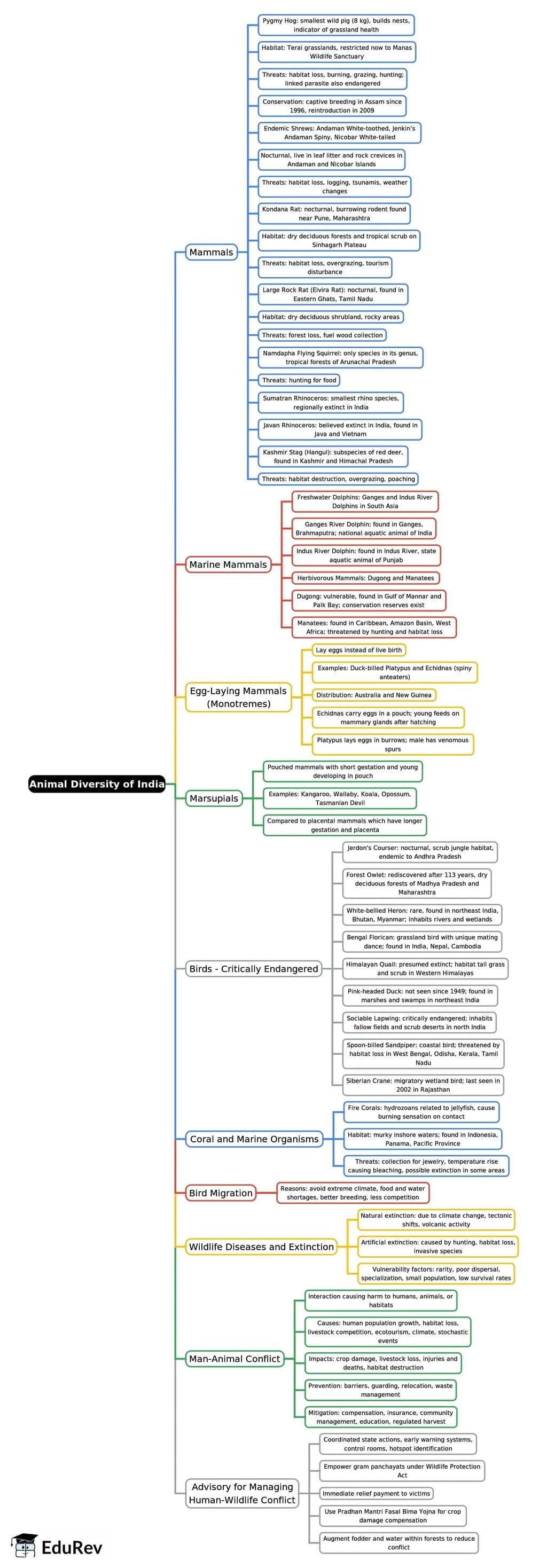UPSC Exam > UPSC Notes > Environment for UPSC CSE > Mind Map: Animal Diversity of India
Mind Map: Animal Diversity of India | Environment for UPSC CSE PDF Download
Animal Diversity of India - 1

Animal Diversity of India - 2

The document Mind Map: Animal Diversity of India | Environment for UPSC CSE is a part of the UPSC Course Environment for UPSC CSE.
All you need of UPSC at this link: UPSC
|
116 videos|303 docs|82 tests
|
FAQs on Mind Map: Animal Diversity of India - Environment for UPSC CSE
| 1. What are the major types of habitats that support animal diversity in India? |  |
Ans. India is home to a wide range of habitats that support its rich animal diversity. Major habitats include forests (tropical, temperate, and alpine), grasslands, wetlands, deserts, and marine environments. Each of these habitats provides unique ecological niches, contributing to the overall biodiversity. For instance, the Western Ghats are renowned for their tropical forests and endemic species, while the Thar Desert houses adapted fauna that thrive in arid conditions.
| 2. How does India's geographical location contribute to its animal diversity? |  |
Ans. India's geographical position, bordered by the Himalayas to the north and surrounded by oceanic bodies on three sides, has created diverse climatic conditions. This variety in climate, along with the presence of different altitudes and ecosystems, allows for a wide range of flora and fauna. The Himalayas serve as a barrier and a habitat for unique species, while coastal regions support marine life, enhancing the overall biodiversity of the country.
| 3. What are some of the key conservation efforts in India to protect animal diversity? |  |
Ans. Key conservation efforts in India include the establishment of national parks, wildlife sanctuaries, and biosphere reserves aimed at protecting critical habitats and endangered species. Initiatives like Project Tiger and Project Elephant focus on the conservation of iconic species. Additionally, community-based conservation programs aim to involve local populations in wildlife protection, ensuring sustainable coexistence and reducing human-wildlife conflict.
| 4. What role do endemic species play in the animal diversity of India? |  |
Ans. Endemic species are crucial for maintaining the ecological balance and health of ecosystems in India. They are species that are native to a particular region and not found elsewhere. India's unique topography and climate have resulted in a high number of endemic species, particularly in biodiversity hotspots like the Western Ghats and the Northeastern region. Protecting these species is essential for preserving genetic diversity and ensuring ecosystem resilience.
| 5. How do human activities impact animal diversity in India? |  |
Ans. Human activities such as deforestation, urbanization, pollution, and poaching have significant adverse effects on animal diversity in India. Habitat destruction leads to loss of living space for many species, while pollution can degrade ecosystems and harm wildlife. Additionally, illegal wildlife trade poses a severe threat to endangered species. Conservation strategies need to address these human-induced challenges to protect India’s rich animal diversity effectively.
Related Searches
















